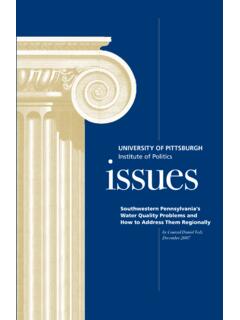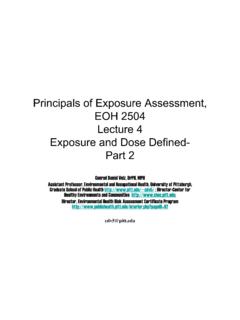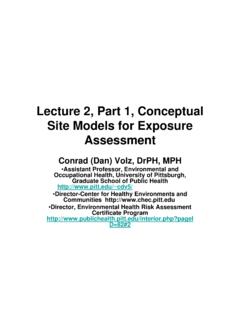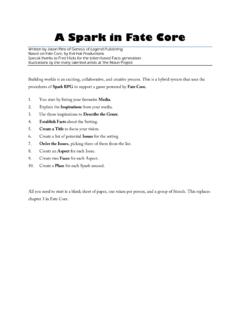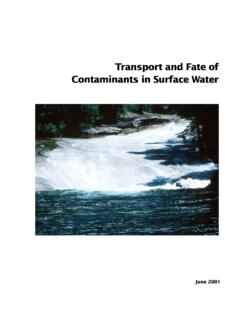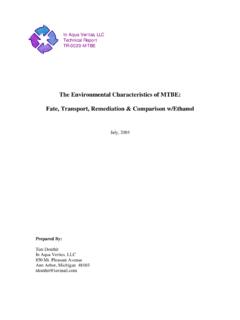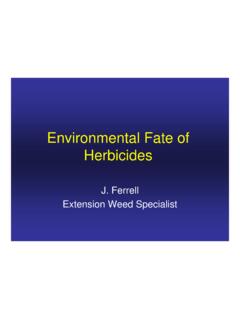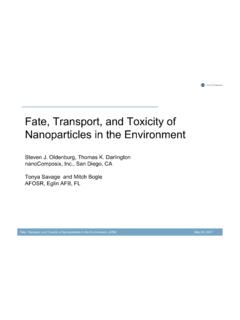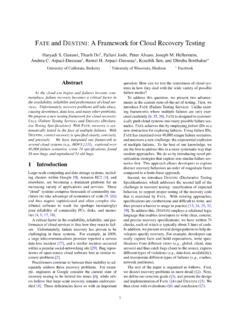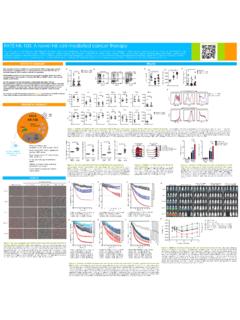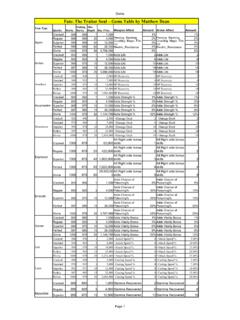Transcription of Lecture 2 Introduction to Environmental Contaminant Fate ...
1 EOH 2122 transport & FATE OF Environmental AGENTS6:00PM 9:00PM Wed A216 Public HealthInstructor: Conrad D. Volz, DrPH, MPH and Jim Peterson BSc, 2 Introduction to Environmental Contaminant Fate and transport : Basic Concepts and Physics Review, Mass Balance and the Control Volume and Advective and Fickian TransportDefinitions Chemical transport - processes that move chemicals through Environmental media. Chemical Fate- The eventual disposition of a chemical Contaminant . This can include destruction or long term storage in a sink and/or exposure-biotransformation in ecological and human of Environmental Media - Air Surface Water Sediment Groundwater-Saturated Zone Soil-Topsoils Subsurface area-Vadose Zone-Unsaturated Zone Food and Waste Coke Oven PlantAirSoil Vadose ZoneGroundwaterSedimentPrecipitationResu spensionDepositionResuspensionSurface WaterRunoffSedimentationResuspensionRech arge orInfiltrationOutflowDepositionLeachingE missionsRunoffDirect ContactIngestionPublicWorkerBiotaxxx xxx xxxxxx xxx xxxxxxxxxxxx xxx xxxxxxxxxxxx xxx xxxxxxxxxFood WebDirect ContactFood WebIngestionDirect SuctionDepositionDispersionEvaporation/V olatilizationInhalationWhy study the fate and transport of Environmental contaminants?
2 Chemicals released into the environment do not respect media boundaries or political boundaries. Exchanges continually occur between different Environmental media so modeling transport within only one medium will not completely describe the chemicals fate. Knowledge of the principals of fate and transport allows predictive capability of the movement of chemicals for both Environmental monitoring validation and development of engineering, institutional and/ or administrative Concentration The chemical concentration is the measure of the mass of a chemical in a specific volume or mass of air, water, soil etc. In our work it will be defined as C. [M/L3] units in text where M is mass and L is length-further T is of Concentration Water-Most common expression of concentration is mass of chemical per unit volume of water or { Mass/Length3}, in the textbook referred to as [M/L3].Common units are mg, g per cm3or per liter of , M,is the number of moles of a chemical per liter of water, mol/l.
3 Where a mole is 1023atoms or molecules Units of Concentration Water -Normality (n) refers to the number of equivalents of a chemical per liter of water, where an equivalent is the amount of chemical that possesses or transfers one mole of electronic charge. So normalityN=# of electronic charge units per mole/literExample: a mole of sulfate SO4-2 is 2 equivalents and a 1 M solution of Na2 SO4 is 2 of Chemical Concentration Water - Unitless parts per million by volume { ppm (v)} can also express chemical concentration in water. Since 1 g/cm3is the density of water than 1 ppm is 1 mg/liter of of Chemical Concentration Soil- Expressed in mass per unit volume of soil [M/L3] , commonly mg/cm3or But this is a problem as soil can be compressed or expanded so the best way to describe concentration is mass chemical/ mass C= mg chemical / kgsoil- Unitless ppm (w) is mg chemical / kgsoil and ppb is g chemical / of Chemical Concentration Air -chemical concentration is commonly expressed as mass off chemical per unit volume of air [M/L3], such as mg/m3or mg or g/ liter But this is a problem again because the volume of a given mass of air changes according to the ideal gas law with temperature and pressure.
4 Best to describe concentration in [M such as mg chemical / M such as kg air].Units of Chemical Concentration Air concentration can be expressed in ppm (v). So 1 ppm of helium in air is 1ml Helium per 1000 liters (1 m3) of chemical in air = (mg/m3) ( )/gram molecular weight of substanceThis conversion is based on a barometric pressure of 760 torr and 25 C temperature. Can use the ideal gas law as we shall see to adjust volumes to changing temperatures and Mass-determined by measuring the force exerted on an amount of a substance by gravity or by inertia. SI units of mass are the gram (g) and kilogram (k). The pound (lb) still in use in the English system is really a unit of force-a pound of soil is that amount that gravity exerts one pound of force on. In our text mass is referred to as [M].Review- Length and Time SI units of meter (m) and centimeter (cm). English unit is the foot (ft) Table A-2, page 416, gives units of length and interconversion factors and page 417, Table A-3 gives multiplier prefixes for SI unit use.
5 Time-SI unit is the second (sec) but useful to use hours, days, years and 70 year , Area and Volume Area is defined in text as [L2] and is commonly expressed as square meters (m2). Table A-4, page 418 presents other area units and interconversion factors {ft2, acre, mi2, are commonly used}. Volume in text is defined as [L3]. Common SI unit is cubic meter (m3) but in Environmental chemistry the liter is often used. 10 3liters= 1 m3, interconversion volume factors are on page 418, table Force F =mass [M]* acceleration [L/T2]. F in dynes(dyn) is in units [ML/T2]. 1 dyn is the amount of force that gives a gram of mass an acceleration of 1 cm/sec2. Newton (N) is the force required to accelerate 1 kg of mass at a rate of 1 m/sec2. A kg- force is N, the weight of a mass of 1 kg at the earths surface. Table A-6, page 419 has force interconversion Pressure is force per unit area and SI unit is Pascal which is = F * (L2) or [ML/T2] * [L2] = [M/LT2] pressure is often expressed in kg/(m*sec2).
6 -Other pressure units are mm Hg, atm=760 mm Hg, barr and psi. Interconversion units are given in Table A-7, page Energy is the capability to perform work can be potential of kinetic. SI unit is the joule (J). 1J = energy conveyed by a force of 1N exerted over a distance of 1 m- units commonly in kg * m2/sec2). Book notation [ML2/T2] Power Power is the rate at which energy is transferred so has dimensions of [ML2/T3]. 1 Watt (W) = 1 J/sec, Table A-9 has power interconversion factors, page and Molecular Weight The atomic weight of an element is equal to the mass in grams of a mole ( 1023atoms) of the element. The molecular weight (MW) of a molecule is the sum of the atomic weights of all its elementsGas Constant Important constant in the Ideal Gas Law PV =nRTWhere P is pressure, V is volume, n is the number of moles of a chemical, R is the gas constant and T is absolute temperature (By international agreement, absolute zero is defined as precisely 0 K on the Kelvin scale, which is a thermodynamic (absolute) temperature scale, and C on the Celsius scale and F on the Fahrenheit scale).
7 J/(mol* K) is the SI Gas ConstantMass Balance and Units Mass balance or mass conservation is an application of conservation of mass (matter cannot disappear or be created spontaneously) to the analysis of physical systems. By accounting for material entering and leaving a system, mass flows can be identified which might have been unknown, or difficult to measure without this technique. For a particular chemical present at a specific location at a certain time there are three possible outcomes-the chemical can remain in that location and/or-the chemical can be transported elsewhere and/or-the chemical can be transformed into another Balance and Units Control volume- any closed volume, across whose boundaries we propose to account for all transport of a chemical, and within whose boundaries we can account for all chemical initially present (stored) as well as all processes that produce (sources) or consume (sinks) the chemical. Common control volumes are lakes as shown in figure Balance Expression storage mass in control volume = mass transportedin- mass transportedout+ mass produced by sources - mass consumed by sinks Also Rate of in storage mass = [M/T] in-[M/T] out + [M/T] sources - [M/T] sinks.
8 If all but one of the terms are known, or can be estimated, then the mass balance expression can be rearranged to determine an otherwise unmeasurable transport , source, or sink term. Steady state situations result in a net storage of 1-1, page 8 Discharge pipe input rate= 20 kg/day butanol Stream input rate = 0 Stream output rate = (storage in control volume) (streamflow @ outlet) = (10-4 kg/m3) (3*104m3/day) = 3 kg/day Assume no internal sources of butanol=0 Lake is at steady state at 10-4 kg/m3 so rate of change of storage is = 20 kg/day + 0 3 kg/day + 0 [M/T] sinks [M/T] sinks = 20 kg/day 3 kg/day = 17 kg/dayInternal sink process unknown-could be biodegradation, fish consumption or sequestration in transport Mechanisms Advection- The bulk movement of fluids (air-water) from one place to another moves the chemical. Bulk movement of fluid in some particular direction is called advection; with prevailing winds and flowing streams being good examples.
9 (direction-vector and velocity-magnititude) The term convection,stemming from density variation in different regions of a fluid, is sometimes used to describe vertical advection, as encountered in weather patterns and ocean Continued In the context of advection, it is convenient to define fluxdensity(J) as the mass of some chemical flowing across an imaginary surface of unit area per unit area normal to fluid flowConcentration (C)Fluid velocity (V)Flux J = smoke plume,or flowing streamWhere Vis velocity, and C is concentration. J is thus in units of [ M/L2T][you have to chose the particular consistent (!) system of units]; 1-2:C= 20 mg/L = mg/mL = mg/cm3J= ( mg/cm3) (100 cm/s) = mg/cm2 sPeterson, 2006 Fickian processes Fickian transport -Molecular diffusion-chemical moves, due to random molecular motion, from a location where its Cis high to one where it is relatively lower. -Turbulent diffusion-random motion of the fluid (air water) that carries the Diffusive transport -Combination of molecular and turbulent Dispersion- model transport as Fickian if movement is complex such as movement of water through on Dispersive transport Dispersioninvolves net movement of an agent down a concentration gradient by several mechanisms which all exhibit approximately Fickian behavior.
10 We are usually concerned with dispersion normal to the prevailing direction of fluid flow; in conjunction with advection. Turbulentdiffusionby means of circulating eddy currents tangential to the flow is the dominant process. Where it exists, mechanicaldispersion( flowing through a particle bed) is the next largest effect. The true Fickian process of moleculardiffusionis usually a minor contributor and any animalactivityis insignificant most of the time. Peterson, 2006 Ficks First Law Fick s first law (in one dimension) is J= D(dC/dx) where Jis now the dispersive flux density[ M/L2T], Dis the Fickian mass transport coefficient- diffusion coefficient [L2T], Cis the concentration of the agent [M/L3], xis the distance [L] and the minus sign shows the concentration gradient to be negative. D is called the a turbulent (or eddy) diffusion coefficient when it is because of fluid turbulence. Unit area normal toconcentration gradient DecreasingconcentrationJ = -D(dC/dx)Center of flowDirection of flowx-axis So if flux density has the units mass/(length2 time) and the concentration per distance must be mass/(length3 length), then the diffusion coefficient has to have units of length2/time.
